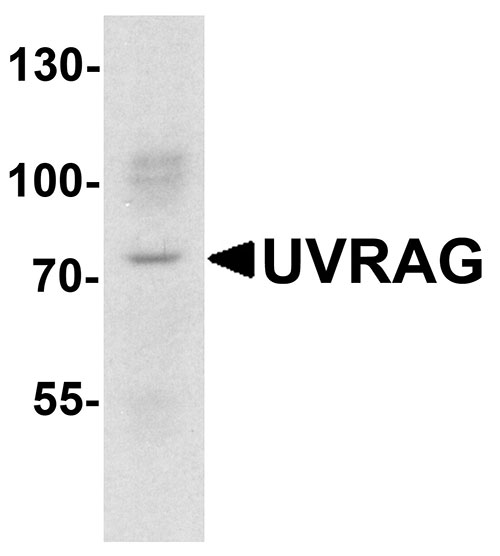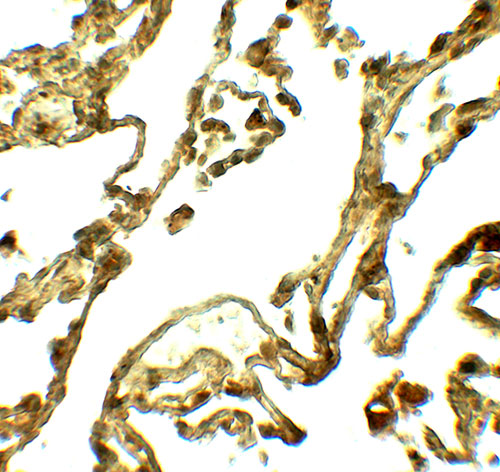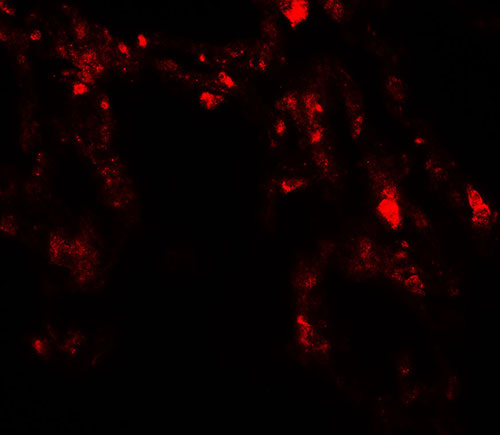UVRAG Antibody
- 产品详情
- 实验流程
- 背景知识
Application
| WB, IF, E, IHC-P |
|---|---|
| Primary Accession | Q9P2Y5 |
| Other Accession | NP_003360, 21687212 |
| Reactivity | Human, Mouse |
| Host | Rabbit |
| Clonality | Polyclonal |
| Isotype | IgG |
| Calculated MW | 78151 Da |
| Concentration (mg/ml) | 1 mg/mL |
| Conjugate | Unconjugated |
| Application Notes | UVRAG antibody can be used for detection of UVRAG by Western blot at 1 - 2 µg/ml. Antibody can also be used for Immunohistochemistry starting at 5 µg/mL. For immunofluorescence start at 20 µg/mL. |
| Gene ID | 7405 |
|---|---|
| Other Names | UV radiation resistance-associated gene protein, p63, UVRAG |
| Target/Specificity | UVRAG; UVRAG antibody is human and mouse reactive. |
| Reconstitution & Storage | UVRAG antibody can be stored at 4℃ for three months and -20℃, stable for up to one year. |
| Precautions | UVRAG Antibody is for research use only and not for use in diagnostic or therapeutic procedures. |
| Name | UVRAG |
|---|---|
| Function | Versatile protein that is involved in regulation of different cellular pathways implicated in membrane trafficking. Involved in regulation of the COPI-dependent retrograde transport from Golgi and the endoplasmic reticulum by associating with the NRZ complex; the function is dependent on its binding to phosphatidylinositol 3- phosphate (PtdIns(3)P) (PubMed:16799551, PubMed:18552835, PubMed:20643123, PubMed:24056303, PubMed:28306502). During autophagy acts as a regulatory subunit of the alternative PI3K complex II (PI3KC3-C2) that mediates formation of phosphatidylinositol 3-phosphate and is believed to be involved in maturation of autophagosomes and endocytosis. Activates lipid kinase activity of PIK3C3 (PubMed:16799551, PubMed:20643123, PubMed:24056303, PubMed:28306502). Involved in the regulation of degradative endocytic trafficking and cytokinesis, and in regulation of ATG9A transport from the Golgi to the autophagosome; the functions seems to implicate its association with PI3KC3-C2 (PubMed:16799551, PubMed:20643123, PubMed:24056303). Involved in maturation of autophagosomes and degradative endocytic trafficking independently of BECN1 but depending on its association with a class C Vps complex (possibly the HOPS complex); the association is also proposed to promote autophagosome recruitment and activation of Rab7 and endosome-endosome fusion events (PubMed:18552835, PubMed:28306502). Enhances class C Vps complex (possibly HOPS complex) association with a SNARE complex and promotes fusogenic SNARE complex formation during late endocytic membrane fusion (PubMed:24550300). In case of negative- strand RNA virus infection is required for efficient virus entry, promotes endocytic transport of virions and is implicated in a VAMP8- specific fusogenic SNARE complex assembly (PubMed:24550300). |
| Cellular Location | Late endosome. Lysosome. Cytoplasmic vesicle, autophagosome. Early endosome. Endoplasmic reticulum. Midbody. Chromosome, centromere. Note=Colocalizes with RAB9-positive compartments involved in retrograde transport from late endosomes to trans-Golgi network. Colocalization with early endosomes is only partial (PubMed:24056303). Recruited to autophagosome following interaction with RUBCNL/PACER (PubMed:28306502) |
| Tissue Location | Highly expressed in brain, lung, kidney and liver. |
For Research Use Only. Not For Use In Diagnostic Procedures.
Provided below are standard protocols that you may find useful for product applications.
BACKGROUND
The class III type phosphoinositide 3-kinase (PI3KC3) / Vps34 regulates vacuolar trafficking as well as autophagy (1). UVRAG (UV radiation resistance-associated gene) is associated with the Beclin-1/PI3KC3 complex and promotes PI3KC3 enzymatic activity and autophagy, while suppressing proliferation (2). UVRAG is highly expressed in brain, lung, kidney and liver and contains one C2 domain, which is involved in calcium-dependent phospholipid binding. Beclin-1 binding to UVRAG promotes both autophagosome maturation and endocytic trafficking (3). UVRAG is also a potential tumor suppressor protein with frameshift mutations observed in colon and gastric carcinomas (4,5).
REFERENCES
Stack JH, DeWald DB, Takegawa K, et al. Vesicle-mediated protein transport: regulatory interactions between the Vps15 protein kinase and the Vps34 PtdIns 3-kinase essential for protein sorting to the vacuole in yeast. J. Cell Biol. 1995; 129:321-34.
Liang C, Feng P, Ku B, et al. Autophagic and tumour suppressor activity of a novel Beclin1-binding protein UVRAG. Nat. Cell Biol. 2006; 8:688-99.
Liang C, Lee JS, Inn KS, et al. Beclin1-binding UVRAG targets the class C Vps complex to coordinate autophagosome maturation and endocytic trafficking. Nat. Cell Biol. 2008; 10:776-87.
Ionov Y, Nowak N, Perucho M, et al. Manipulation of nonsense mediated decay identifies gene mutations in colon cancer Cells with microsatellite instability. Oncogene 2004; 23:639-45.
终于等到您。ABCEPTA(百远生物)抗体产品。
点击下方“我要评价 ”按钮提交您的反馈信息,您的反馈和评价是我们最宝贵的财富之一,
我们将在1-3个工作日内处理您的反馈信息。
如有疑问,联系:0512-88856768 tech-china@abcepta.com.























 癌症的基本特征包括细胞增殖、血管生成、迁移、凋亡逃避机制和细胞永生等。找到癌症发生过程中这些通路的关键标记物和对应的抗体用于检测至关重要。
癌症的基本特征包括细胞增殖、血管生成、迁移、凋亡逃避机制和细胞永生等。找到癌症发生过程中这些通路的关键标记物和对应的抗体用于检测至关重要。 为您推荐一个泛素化位点预测神器——泛素化分析工具,可以为您的蛋白的泛素化位点作出预测和评分。
为您推荐一个泛素化位点预测神器——泛素化分析工具,可以为您的蛋白的泛素化位点作出预测和评分。 细胞自噬受体图形绘图工具为你的蛋白的细胞受体结合位点作出预测和评分,识别结合到自噬通路中的蛋白是非常重要的,便于让我们理解自噬在正常生理、病理过程中的作用,如发育、细胞分化、神经退化性疾病、压力条件下、感染和癌症。
细胞自噬受体图形绘图工具为你的蛋白的细胞受体结合位点作出预测和评分,识别结合到自噬通路中的蛋白是非常重要的,便于让我们理解自噬在正常生理、病理过程中的作用,如发育、细胞分化、神经退化性疾病、压力条件下、感染和癌症。








